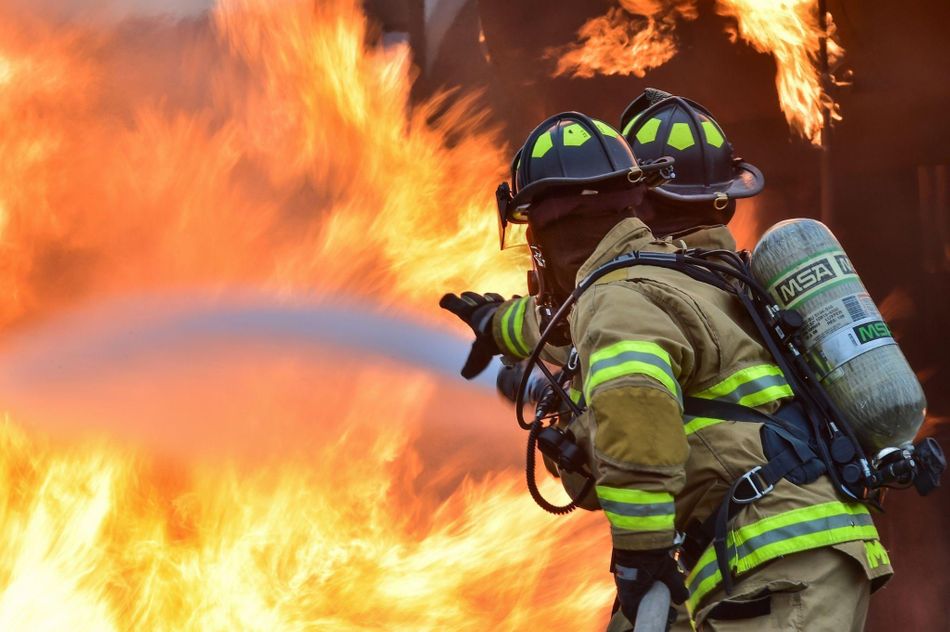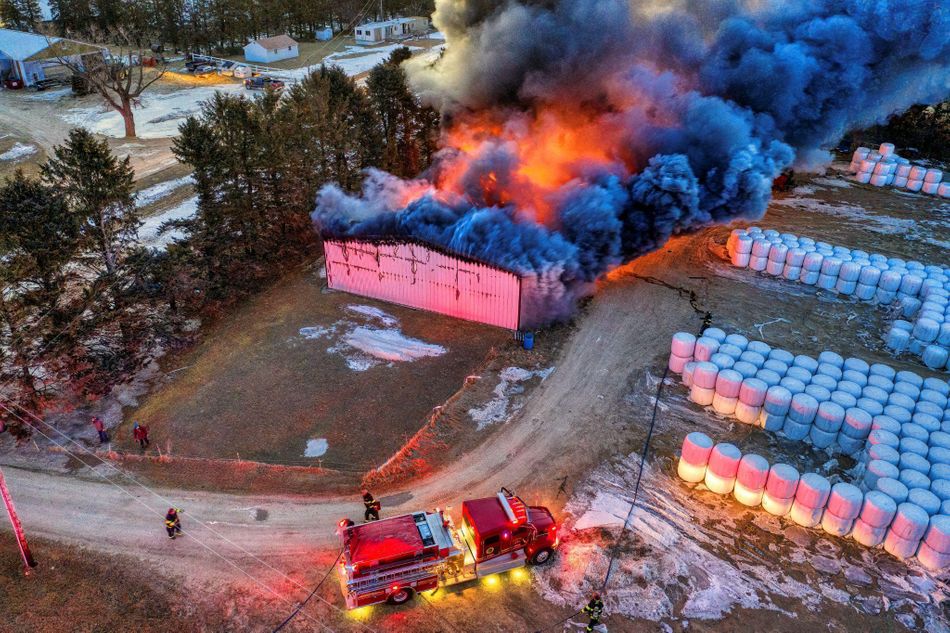Why drones are the next step to managing dire responses globally
As the global adoption of uncrewed vehicles gains momentum in firefighting operations, it's evident that these technological advancements hold immense potential.
Why drones are the next step to managing dire responses globally
In 2023, the frequency and severity of wildfires have escalated in both the northern and southern hemispheres. The World Meteorological Organization (WMO) reports indicate a notable increase in the occurrence of wildfires across the globe, primarily caused by record levels of heat-trapping greenhouse gases.[1] This increased risk of wildfire frequency and intensity are caused by climate change and land-use change, making extreme wildfires serious threats even in areas previously unaffected.[2]
Several significant wildfires occurred in 2023, highlighting the need for robust firefighting solutions. As further intense weather is only likely to continue and with wildfires continuing to pose significant challenges to traditional firefighting efforts, innovative solutions are necessary.
Drone control from the ground
Uncrewed vehicles (UCVs) have emerged as a transformative technology in fire response, providing enhanced surveillance, firefighting capabilities, and increased safety for responders. Their abilities are heightened through the use of sophisticated navigation systems that enable precision and control for thousands of vehicles at once. Cloud Ground Control (CGC) is one such system, which offers several essential tools for the coordination of drones and other UCVs in fire mitigation, like swarm control, security, and real-time video feeds.
CGC offers a state-of-the-art cloud-based command and control solution, focused on unifying individual uncrewed vehicles into a coordinated fleet. AI and robotics company Advanced Navigation have recently developed and launched their CGConnect modem, which allows fleet managers to live-stream, command, and control fleets of drones – enabling access to an unlimited number of machines via a web browser.[3]
CGConnect offers an array of capabilities, encompassing robust security protocols to safeguard data and intellectual property against potential vulnerabilities. The user-friendly interface caters to both seasoned drone pilots and novices alike. Additionally, the integration of on-the-edge AI empowers advanced object recognition and classification, further enhancing the system's functionality.
Through real-time access to telemetry, video feeds, and payload data from various uncrewed vehicles, CGC enhances situational awareness and improves the speed and efficacy of decision-making.
This technology-driven approach significantly reduces operational risks and bolsters response times, making it an increasingly important player in fire responses around the world.
How utilising technology make a difference in wildfire management
Besides risking their lives by battling flames, fire responders also jeopardise their long-term health through exposure to toxic chemicals, fumes, and other occupational hazards.[4]
As such, there has been keen interest in the last few years of deploying uncrewed vehicles, both on land and in the air, and managing the fleet holistically using technology like CGC,[5] to keep wildfires at bay while minimising risk to the lives, health, and wellbeing of responders.[6]
Unmanned ground vehicles (UGVs) equipped with state-of-the-art equipment have revolutionised firefighting operations, and have had a profound impact on firefighter safety and operational efficiency.[7] They are safer for firefighter, both in terms of saving lives and preventing damage to their health, they are more likely to be able to rescue both wildlife and humans, and are more likely to predict where fires will spread next.
UGVs are specifically designed to navigate treacherous and hazardous terrains, where human responders face significant risks. These robots are equipped with thermal cameras and gas sensors, which enable them to detect and assess fire conditions with exceptional accuracy.
They are also able to autonomously manoeuvre through complex environments, overcoming obstacles and accessing remote areas that might be inaccessible or perilous for human firefighters. Their robust all-terrain capabilities, including rugged wheels or tracks, allow them to traverse challenging landscapes, such as dense forests, mountainous regions, or urban rubble, ensuring that no area is beyond their reach.[8]
To augment their firefighting capabilities, these rovers are equipped with cutting-edge technologies, such as advanced fire suppression systems, including high-pressure water cannons or foam dispensers which can blast up to 20,000L of water per minute, enabling rapid and precise fire suppression efforts.[9]
Aerial drones, also known as unmanned aerial vehicles (UAVs), equipped with high-resolution cameras have proven invaluable for wildfire surveillance and monitoring. Their manoeuvrability, autonomy, ease of deployment, and low cost make them very attractive options for fire detection and prediction, autonomous navigation, obstacle avoidance, and search & rescue operations.[10]
UAVs are incredibly adept at detecting and mapping fire perimeters, identifying hotspots, and predicting fire spread. Real-time aerial data captured by drones, coupled with remote-sensing capabilities, are used with artificial intelligence, machine learning, and deep-learning algorithms to detect fire regions, make predictions, make decisions, and optimise fire-monitoring tasks. This enables firefighters to make informed decisions and allocate resources efficiently, while minimising their risk and exposure.
Moreover, UAVs equipped with various advanced sensors, including light detection and ranging (LIDAR), visual, infrared (IR), and monocular cameras, have been used to monitor bushfires due to their potential to provide new approaches and research opportunities.[11]
Technological innovations such as sensors enable fire response teams to access enhanced situational awareness and earlier fire detection. These sensors enable accurate assessment of fire behaviour and aid in developing effective response strategies. By providing real-time data, uncrewed vehicles equipped with advanced technologies empower firefighters to respond swiftly and efficiently.
The risks of deploying uncrewed drones to fight fires
Despite all the benefits associated with deploying uncrewed drones in firefighting operations, these operations are not without their challenges.
There is a need for clear visibility and understanding of the drone's operational status, such as its location, flight path, and payload utilisation. Limited shared situational awareness between drone operators and firefighting teams can hinder effective coordination and decision-making during critical moments.[12]
Additionally, there is a need for seamless information exchange between drone operators, incident commanders, and ground personnel. Timely and accurate transmission of real-time data, such as aerial imagery or sensor readings, is essential for informed decision-making and resource allocation. However, technological limitations, such as limited bandwidth or line-of-sight restrictions, can impede this, making effective communication a challenge.[13]
Integrating drones into the existing firefighting systems can be a complex procedure. It requires the effective simultaneous coordination of drone multiple operations - managing flight path, altitude, and timing while avoiding collisions. It also requires integration with ground operations - which hinges on shared situational awareness, operational transparency, and effective communication. Thirdly, the limited airspace and flight restrictions drones face add to the challenge of an effective, coordinated drone deployment.[14]
Cloud Ground Control technology allows effortless coordination of thousands of uncrewed fire response vehicles
The challenges presented by a fire-response drone deployment can be overcome in part by a cloud ground-control system.
Cloud ground control offers a centralised platform for command and control, allowing operators to remotely monitor and manage thousands of drones simultaneously, from one screen.[15]
The integration of cloud ground control systems with advanced analytics and visualisation tools enhances situational awareness by providing a comprehensive view of the fire incident and drone operations. This enables operators to optimise drone utilisation, allocate resources efficiently, and coordinate their actions with ground personnel.
By leveraging cloud-based technologies, the challenges of deploying uncrewed drones can be effectively mitigated, enhancing the capabilities and impact of these autonomous systems in fire response operations.
Conclusion
As the global adoption of uncrewed vehicles gains momentum in firefighting operations, it's evident that these technological advancements hold immense potential.
However, addressing challenges related to coordination, decision-making, and integration remains crucial for wider implementation. By seamlessly incorporating CGC technologies into the equation, uncrewed vehicles can effectively be harnessed for coordinated and strategic fire responses.
CGC's real-time monitoring, data analysis, and remote management capabilities serve as a linchpin in optimising uncrewed vehicle actions, ultimately reshaping fire mitigation strategies on a global scale.
References
[1] WMO. WMO Statement on the State of the Global Climate [Internet]. World Meteorological Organization. 2022. Available from: https://public.wmo.int/en/our-mandate/climate/wmo-statement-state-of-global-climate
[2] Spreading like Wildfire: The Rising Threat of Extraordinary Landscape Fires [Internet]. United Nations Environment Programme. UNEP; 2022 Feb [cited 2023 Jun 16]. Available from: https://www.unep.org/resources/report/spreading-wildfire-rising-threat-extraordinary-landscape-fires
[3] DEOHS DL is a communications specialist for. Preventing long-term health risks for firefighters [Internet]. UW DEOHS. 2023. Available from: https://deohs.washington.edu/hsm-blog/preventing-long-term-health-risks-firefighters
[4] Emergency Services Ergonomics and Wellness [Internet]. U.S. Fire Administration. 2021. Available from: https://www.usfa.fema.gov/a-z/health-safety-wellness/ergonomics/ch1-firefighter-injuries.html
[5] HWSAdmin. The Mental Health of Our Fire Fighters [Internet]. The Brain Collective. 2022. Available from: https://www.thebraincollective.co.uk/whos-looking-after-the-mental-health-of-our-fire-fighters/
[6] UAS In Firefighting: How Unmanned Systems Can Help To Keep The Environment Safe [Internet]. sUAS News - The Business of Drones. 2022. Available from: https://www.suasnews.com/2022/07/uas-in-firefighting-how-unmanned-systems-can-help-to-keep-the-environment-safe/
[7] Ball M. Firefighting UGV Introduced [Internet]. Unmanned Systems Technology. 2021. Available from: https://www.unmannedsystemstechnology.com/2021/06/firefighting-ugv-introduced/
[8] Fire Fighting UGV | Parosha Cheatah GOSAFER [Internet]. Parosha. [cited 2023 Jun 16]. Available from: http://www.parosha-cheatah-gosafer.com/tasks/fire-fighting-ugv/
[9] Ball M. Firefighting UGV Introduced [Internet]. Unmanned Systems Technology. 2021. Available from: https://www.unmannedsystemstechnology.com/2021/06/firefighting-ugv-introduced/
[10] Partheepan S, Sanati F, Hassan J. Autonomous Unmanned Aerial Vehicles in Bushfire Management: Challenges and Opportunities. Drones. 2023 Jan 10;7(1):47.
[11] Ibid
[12] Easy Access Rules for Unmanned Aircraft Systems - Revision from September 2022 [Internet]. EASA. 2022 [cited 2023 Jun 16]. Available from: https://www.easa.europa.eu/en/document-library/easy-access-rules/online-publications/easy-access-rules-unmanned-aircraft-systems?page=5
[13] Mohsan SAH, Othman NQH, Li Y, Alsharif MH, Khan MA. Unmanned aerial vehicles (UAVs): practical aspects, applications, open challenges, security issues, and future trends. Intelligent Service Robotics [Internet]. 2023 Jan 16; Available from: https://www.ncbi.nlm.nih.gov/pmc/articles/PMC9841964/
[14] Gugan G, Haque A. Path Planning for Autonomous Drones: Challenges and Future Directions. Drones. 2023 Feb 28;7(3):169.
[15] Qiu S. Cloud Ground Control empowers emergency response and disaster relief with 5G drone fleet control [Internet]. Advanced Navigation. 2023 [cited 2023 Jun 16]. Available from: https://www.advancednavigation.com/news/cloud-ground-control-empowers-emergency-response-and-disaster-relief-with-5g-drone-fleet-control/



